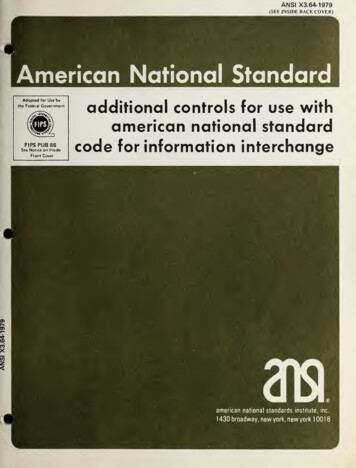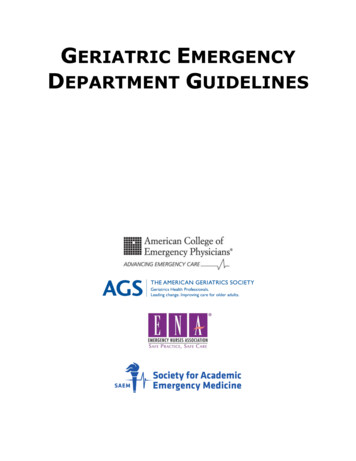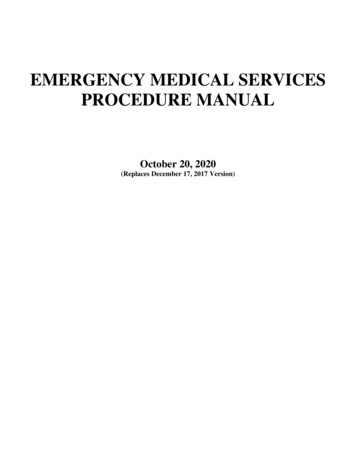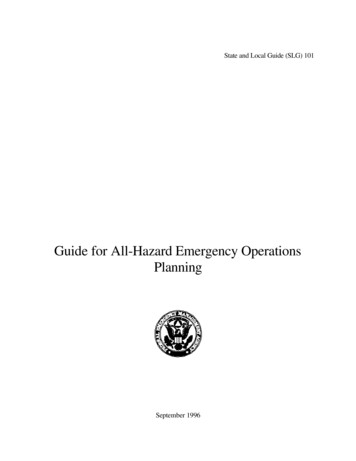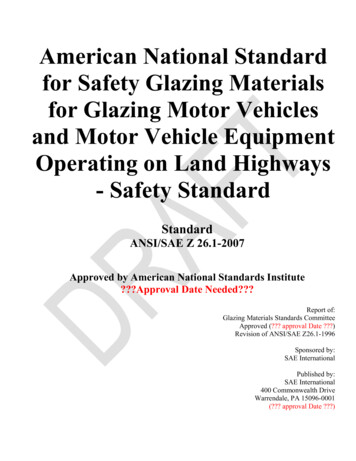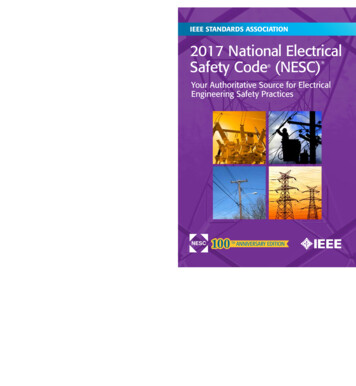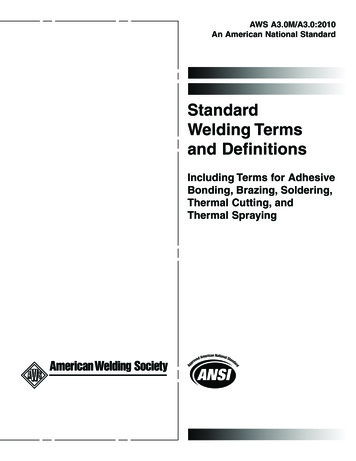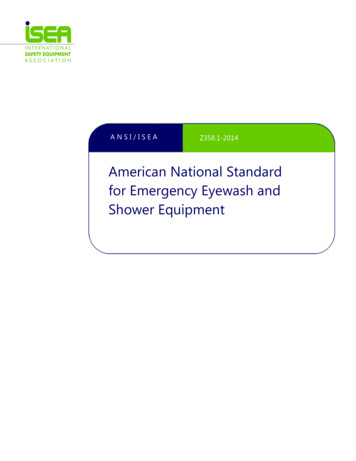
Transcription
ANSI/ISEAZ358.1-2014American National Standardfor Emergency Eyewash andShower Equipment
ANSI/ISEA Z358.1-2014Revision ofANSI/ISEA Z358.1-2009American National Standard forEmergency Eyewash and Shower EquipmentSecretariatInternational Safety Equipment AssociationApproved January 8, 2015American National Standards Institute, Inc.
AmericanNationalStandardApproval of an American National Standard requires verification by ANSI that therequirements for due process, consensus, and other criteria for approval havebeen met by the standards developer. Consensus is established when, in thejudgment of the ANSI Board of Standards Review, substantial agreement hasbeen reached by directly and materially affected interests. Substantial agreementmeans much more than a simple majority, but not necessarily unanimity.Consensus requires that all views and objections be considered, and that aconcerted effort be made toward their resolution. The use of American NationalStandards is completely voluntary; their existence does not in any respectpreclude anyone, whether he/she has approved the standards or not, frommanufacturing, marketing, purchasing, or using products, processes, orprocedures not conforming to the standards. The American National StandardsInstitute does not develop standards and will in no circumstance give aninterpretation of any American National Standard. Moreover, no person shallhave the right or authority to issue an interpretation of an American NationalStandard in the name of the American National Standards Institute. Requests forinterpretation should be addressed to the secretariat or sponsor whose nameappears on the title page of this standard.CAUTION NOTICE: This American National Standard may be revised orwithdrawn at any time. The procedures of the American National StandardsInstitute require that action be taken to reaffirm, revise, or withdraw this standardno later than five years from the date of publication. Purchasers of AmericanNational Standards may receive current information on all standards by calling orwriting the American National Standards Institute.Published byInternational Safety Equipment Association1901 North Moore Street, Suite 808, Arlington, Virginia 22209Copyright by ISEAAll rights reserved.No part of this publication may be reproducedin any form, in an electronic retrieval system orotherwise, without the prior written permissionof the publisher.Printed in the United States of America
Foreword (This Foreword is not part of American National Standard ANSI/ISEA Z358.1-2014)This revision updates ANSI Z358.1-2009 and was prepared by the Emergency Eyewash and ShowerGroup of the International Safety Equipment Association, whose members are thoroughly knowledgeablein the design, installation, and use of this important safety equipment. The following companies weremembers of the group at the time of the approval of the standard: Bradley Corporation, Encon SafetyProducts, FSI International, Guardian Equipment, Honeywell Safety Products, Hughes Safety Showers,Prevor, Inc., Sellstrom Manufacturing, Speakman Company, and VisionAid.Updates to the 2009 version of the standard are reflected in this document, including improvement inlanguage to emphasize that the location of the fluid flow and pattern delivery for emergency eyewashesand eye/face washes is the critical aspect in designing and installing these devices, rather than thepositioning of the nozzles themselves. Additionally, illustrations have been updated to reflectcontemporary design configurations that are known to meet the criteria in standard.Suggestions for the improvement of this standard are welcome. They should be sent to the ISEA, 1901 N.Moore Street, Suite 808, Arlington, VA 22209 or isea@safetyequipment.org.This standard was processed and approved using consensus procedures prescribed by the AmericanNational Standards Institute. The following organizations were contacted prior to the approval of thisstandard. Inclusion in this list does not necessarily imply that the organization concurred with thesubmittal of the proposed standard to ANSI.Acorn SafetyAPPA, Leadership in Educational FacilitiesAlabama Power CompanyArts, Crafts & Theater Safety Inc.Atlantic HealthAtlas Industrial Contractors, LLCBASF CorporationBaylor Scott & White HealthCalOSHACardinal HealthCounty of SacramentoErdmanGreen Conversion SystemsHaws CorporationInternational Safety Equipment AssociationIntertekLawler ManufacturingNatural Resources CanadaNorth Carolina Department of LaborSafety Equipment InstituteSpecial Graphic Imaging AssociationState of Ohio Public Employment Risk ReductionProgramSyracuse UtilitiesUL LLCUniversity of GeorgiaUniversity of MichiganUS Department of the ArmyUS Department of the NavyWilliams Energy
ContentsSECTIONPAGE1.Scope . 12Purpose . 13.Definitions . 14.Emergency Showers . 25.6.7.8.4.1Performance of Emergency Showers . 24.2Performance of Control Valve . 24.3Emergency Shower Enclosures . 24.4Testing Procedures for Certification . 24.5Installation . 34.6Maintenance and Training . 4Eyewash Equipment . 45.1Performance of Eyewashes . 45.2Performance of Control Valve . 45.3Testing Procedures for Certification . 55.4Installation . 55.5Maintenance and Training . 6Eye/Face Wash Equipment . 66.1Performance of Eye/Face Washes . 66.2Performance of Control Valve . 76.3Testing Procedures for Certification . 76.4Installation . 76.5Maintenance and Training . 8Combination Units . 87.1Performance of Combination Units . 87.2Performance of Control Valve . 87.3Testing Procedures for Certification . 87.4Installation . 87.5Maintenance and Training . 9Supplemental Equipment . 98.1Personal Wash Units . 98.2Drench Hoses . 10
SECTIONPAGEILLUSTRATIONSIllustration 1Emergency Shower – Overhead Type . 11Illustration 2Emergency Shower – Multi-Nozzle . 12Illustration 3Emergency Shower – Multi-Nozzle with Overhead Fixture . 13Illustration 4Plumbed Eyewash . 14Illustration 5Nonpressurized Self-Contained Eyewash. 15Illustration 6Pressurized Self-Contained Eyewash . 15Illustration 7Typical Eyewash Gauge . 16Illustration 8Eye/Face Wash . 16Illustration 9Combination Unit . 17Illustration 10Personal Wash Units . 18Illustration 11Drench Hose . 18Illustration 12Drench Hose with Eyewash Attachment . 18APPENDICESAppendix A – Safety Considerations . 19Appendix B – Installation Considerations . 20REFERENCES. . 22
ANSI/ISEA Z358.1-2014American National Standardfor Emergency Eyewash and Shower Equipment1.ScopeThis standard establishes minimum performanceand use requirements for eyewash and showerequipment for the emergency treatment of theeyes or body of a person who has been exposedto hazardous materials. It covers the followingtypes of equipment: emergency showers,eyewashes, eye/face washes, and combinationunits.This standard also includes performance anduse requirements for personal wash units anddrench hoses, which are consideredsupplemental to emergency eyewash andshower equipment.2.PurposeThis standard is intended to provide uniformminimum requirements for the performance,use, installation, test procedures, maintenanceand training of emergency eyewash and showerequipment.3.DefinitionsFor the purpose of this standard, the followingterms apply as defined:certified: A system whereby a certificationorganization determines that a manufacturer hasdemonstrated the ability to produce a productthat complies with the requirements of thisstandard, authorizes the manufacturer to use alabel on listed products that comply with therequirements of this standard, and establishes afollow-up program conducted by the certificationorganization as a check on the methods themanufacturer uses to determine continuedcompliance of labeled and listed products withthe requirements of this standard.certification organization: An independentthird party organization that determines productcompliance with the requirements of thisstandard with a labeling/listing/follow-upprogram.combination unit: An interconnected assemblyof emergency equipment supplied by a singlesource of flushing fluid.drench hose: A supplemental device consistingof a flexible hose connected to a flushing fluidsupply and used to provide fluid to irrigate andflush face and body areas.emergency shower: A device specificallydesigned and intended to deliver flushing fluid insufficient volume to cause that fluid to cascadeover the entire body.eye/face wash: A device used to provide fluidto irrigate and flush both the face and the eyessimultaneously.eyewash: A device used to provide fluid toirrigate and flush the eyes.flow pressure: The pressure in the watersupply pipe near the water outlet while the faucetor outlet is fully open and flowing.flushing fluid: Potable water, preserved water,preserved buffered saline solution or othermedically acceptable solution manufactured andlabeled in accordance with applicablegovernment regulations.flushing fluid column: The dispersion patternof flushing fluid which is created by anemergency shower and meets the standard’sprescribed coverage requirements. This patterncan be achieved by a variety of designconfigurations.freeze protected equipment: Equipmentdesigned to allow the emergency device tooperate under freezing conditions.freeze protection: A means to protect flushingfluid in an apparatus from freezing and renderingit inoperable. This can be achieved throughseveral means including mechanical valves andelectrical heat tracing.hazardous material: Any substance orcompound that has the capability of producingPage 1
ANSI/ISEA Z358.1-2014adverse effects on the health and safety ofhumans.personal wash: A supplementary device thatsupports plumbed and/or self-contained units, bydelivering immediate flushing fluid to the eyes orbody.plumbed: A term used to describe equipmentthat is connected to a continual source ofpotable water.potable water: Water that is suitable fordrinking.self-closing valve: A valve that closesautomatically when released by the user.self-contained: A term used to describe astand-alone device containing flushing fluid.tepid: A flushing fluid temperature conducive topromoting a minimum 15 minute irrigationperiod. A suitable range is 16 - 38º C(60 -100º F). (See Appendix B6).valve actuator: A device connected to thevalve to facilitate its operation.4.Emergency Showers (SeeIllustrations 1, 2, 3)4.1Performance of Emergency Showers4.1.1 A means shall be provided to ensurethat a controlled flow of flushing fluid is providedat a velocity low enough to be non-injurious tothe user.4.1.2 Emergency showers shall be capable ofdelivering flushing fluid at a minimum of75.7 liters per minute (20 gpm) for a minimum of15 minutes. If shut off valves are installed in thesupply line for maintenance purposes, provisionsshall be made to prevent unauthorized shut off.4.1.3 Emergency showers shall provide aflushing fluid column that is at least 208.3 cm (82in.) and not more than 243.8 cm (96 in.) in heightfrom the surface on which the user stands.4.1.4The spray pattern shall have a minimumdiameter of 50.8 cm (20 in.) at 152.4 cm (60 in.)above the surface on which the user stands, andthe center of the spray pattern shall be located atPage 2least 40.6 cm (16 in.) from any obstruction. Theflushing fluid shall be substantially dispersedthroughout the pattern.4.1.5 Emergency showers shall be designed,manufactured and installed in such a mannerthat, once activated, they can be used withoutrequiring the use of the operator’s hands.4.1.6 Emergency showers shall beconstructed of materials that will not corrode inthe presence of the flushing fluid. Storedflushing fluid shall be protected against airbornecontaminants.4.2Performance of Control ValveThe valve shall remain open without the use ofthe operator’s hands until intentionally closed.The valve shall be simple to operate and shall gofrom "off" to "on" in 1 second or less. The valveshall be resistant to corrosion. Manual orautomatic actuators shall be easy to locate andreadily accessible to the user. Valve actuatorsshall be located not more than 173.3 cm (69 in.)above the level on which the user stands.4.3Emergency Shower EnclosuresIf used, enclosures shall provide for a minimumunobstructed area of 86.4 cm (34 in.) indiameter.4.4Testing Procedures for Certification4.4.1Plumbed Emergency ShowersPlumbed emergency showers shall be certifiedas follows:(1) Connect a flowmeter to the unit to betested or provide other means of measuringflushing fluid flow.(2) Connect the unit per the manufacturer’sspecifications to a flushing fluid supply at aflow pressure of 207 kPa 3.4 kPa -0 kPa(30 psi 0.5 psi -0 psi).(3) Open the valve on the unit and verify thatit fully opens in one second or less and thatit stays open.(4) Determine that flushing fluid issubstantially dispersed throughout thepattern. The flushing fluid column pattern
ANSI/ISEA Z358.1-2014shall be at least 208 cm (82 in.) and no morethan 243.8 cm (96 in.) from the surface onwhich the user stands. Measure thediameter of the flushing fluid pattern 152.4cm (60 in.) above the surface on which theuser stands. The diameter shall be aminimum of 50.8 cm (20 in.). Throughoutthe 15-minute test, verify that the flow rate isa minimum of 75.7 liters per minute (20gpm).4.4.2Self-contained Emergency ShowersSelf-contained emergency showers shall becertified as follows:(1) Fill the unit with flushing solution.(2) Connect a flowmeter to the unit to betested or provide other means of measuringflushing fluid flow.(3) Open the valve on the unit and verify thatit fully opens in one second or less and thatit stays open.(4) Determine that flushing fluid issubstantially dispersed throughout thepattern. The flushing fluid column patternshall be at least 208 cm (82 in.) and notmore than 243.8 cm (96 in.) from the surfaceon which the user stands. Measure thediameter of the flushing fluid pattern152.4 cm (60 in.) above the surface onwhich the user stands. The diameter shallbe a minimum of 50.8 cm (20 in.).Throughout the 15-minute test, verify thatthe flow rate is a minimum of 75.7 liters perminute (20 gpm).4.5InstallationIt is the installer’s responsibility to ensure thatemergency showers shall:4.5.1 Be assembled and installed inaccordance with the manufacturer's instructions,including flushing fluid delivery requirements.4.5.2 Be in accessible locations that requireno more than 10 seconds to reach. Theemergency shower shall be located on the samelevel as the hazard and the path of travel shallbe free of obstructions that may inhibit itsimmediate use. (See Appendix B5)4.5.3 Be located in an area identified with ahighly visible sign positioned so the sign shall bevisible within the area served by the emergencyshower. The area around the emergencyshower shall be well-lit.4.5.4 Be positioned so that the shower patternis dispersed such that the top of the flushing fluidcolumn is at least 208.3 cm (82 in.) and notmore than 243.8 cm (96 in.) from the surface onwhich the user stands. The center of the sprayshall be at least 40.6 cm (16 in.) from anyobstruction.4.5.5 Be connected to a supply of flushingfluid per the manufacturer’s installationinstructions to produce the required spraypattern for a minimum period of 15 minutes.Where the possibility of freezing conditionsexists, the emergency shower shall be protectedfrom freezing or freeze-protected equipmentshall be installed. If shut off valves are installedin the shower line for maintenance purposes,provisions shall be made to preventunauthorized shut off.4.5.6 Deliver tepid flushing fluid. Incircumstances where chemical reaction isaccelerated by flushing fluid temperature, afacilities safety/health advisor should beconsulted for the optimum temperature for eachapplication.4.5.7 When the plumbed emergency showeris installed, its performance shall be verified inaccordance with the following procedures:(1) With the unit correctly connected to theflushing fluid source and the valve(s) closed,visually check the piping connections forleaks.(2) Open the valve to the full open position.The valve shall remain open withoutrequiring further use of the operator's hands.(3) With the valve in the fully openedposition, measure the diameter of the spraypattern. It shall be a minimum of 50.8 cm(20 in.) at 152.4 cm (60 in.) above thestanding surface. The flushing fluid shall besubstantially dispersed throughout thepattern.Page 3
ANSI/ISEA Z358.1-2014(4) Using the flowmeter or other means,determine that the rate of flow is at least75.7 liters per minute (20 gpm).(5) Using a temperature gauge or othermeans, determine that the flushing fluid istepid.4.5.8 When the self-contained emergencyshower is installed, its installation shall beverified in accordance with manufacturer’sinstructions.4.6Maintenance and Training4.6.1 Manufacturers shall provide operation,inspection and maintenance instructions withemergency shower equipment. Instructions shallbe readily accessible to maintenance andtraining personnel.4.6.2 Plumbed emergency showers shall beactivated weekly for a period long enough toverify operation and ensure that flushing fluid isavailable. (See Appendix B7)4.6.3 Self-contained emergency showers shallbe visually checked weekly to determine ifflushing fluid needs to be changed orsupplemented. Such inspection shall beconducted in accordance with manufacturer’sinstructions.4.6.4 Employees who may be exposed tohazardous materials shall be instructed in thelocation and proper use of emergency showers.4.6.5 All emergency showers shall beinspected annually to assure conformance withSection 4.5 requirements of this standard.5.Eyewash Equipment (SeeIllustrations 4, 5, 6)5.1Performance of Eyewashes5.1.1 A means shall be provided to ensurethat a controlled flow of flushing fluid is providedto both eyes simultaneously at a velocity lowenough to be non-injurious to the user.5.1.2 The eyewash shall be designed andpositioned in such a way as to pose no hazard tothe user.Page 45.1.3 Nozzles and flushing fluid units shall beprotected from airborne contaminants.Whatever means is used to afford suchprotection, its removal shall not require aseparate motion by the operator when activatingthe unit.5.1.4 Eyewashes shall be designed,manufactured and installed in such a mannerthat, once activated, they can be used withoutrequiring the use of the operator’s hands.5.1.5 Eyewashes shall be constructed ofmaterials that will not corrode in the presence ofthe flushing fluid.5.1.6 Eyewashes shall be capable ofdelivering flushing fluid to the eyes not less than1.5 liters per minute (0.4 gpm) for 15 minutes. Ifshut off valves are installed in the supply line formaintenance purposes, provisions shall be madeto prevent unauthorized shut off.5.1.7 Eyewashes shall be designed to provideenough room to allow the eyelids to be heldopen with the hands while the eyes are in theflushing fluid stream.5.1.8 Eyewashes shall provide flushing fluid toboth eyes simultaneously. A test gauge formaking determination of a suitable eyewashpattern shall be a minimum 10.16 cm (4 in.) inlength with two sets of parallel lines equidistantfrom the center (See Illustration 7). The interiorset of lines shall be 3.18 cm (1.25 in.) apart andthe exterior lines shall be 8.26 cm (3.25 in.)apart. Place the gauge in the stream of theeyewash. The flushing fluid shall cover theareas between the interior and exterior lines ofthe gauge at some point less than 20.3 cm(8 in.) above the eyewash nozzle(s).5.2Performance of Control ValveThe valve shall remain open without the use ofthe operator’s hands until intentionally closed.The valve shall be simple to operate and shall gofrom "off" to "on" in 1 second or less. The valveshall be resistant to corrosion. Manual orautomatic actuators shall be easy to locate andreadily accessible to the user.
ANSI/ISEA Z358.1-20145.3Testing Procedures for Certification5.4Installation5.3.1Plumbed EyewashesIt is the installer’s responsibility to ensure thateyewashes shall:Plumbed eyewashes shall be certified as follows:(1) Connect a flowmeter to the unit to betested, or provide other means of measuringflushing fluid flow.(2) Connect the unit to a flushing fluidsupply per the manufacturer’s instructions ata flow pressure of 207 kPa 3.4 kPa -0 kPa(30 psi 0.5 psi -0 psi).(3) Open the valve on the eyewash andverify that it fully opens in one second or lessand that it stays open.(4) Throughout the 15 minute test, ensurethat the unit is capable of delivering aminimum of 1.5 liters per minute (0.4 gpm)and that the flushing fluid covers the areasbetween the interior and exterior lines of thegauge at some point less than 20.3 cm(8 in.) above the eyewash nozzle(s)(Illustration 7).5.3.2Self-contained EyewashesSelf-contained eyewashes shall be certified asfollows:(1) Set up the unit per the manufacturer’sinstructions.(2) Fill the unit with flushing fluid or with thepre-packaged fluid provided by themanufacturer.(3) Activate the unit and verify that it can beactivated in one second or less and that itstays activated.(4) Throughout the 15 minute test, ensurethat the eyewash is capable of delivering aminimum of 1.5 liters per minute (0.4 gpm)and that the flushing fluid covers the areasbetween the interior and exterior lines of thegauge at some point less than 20.3 cm(8 in.) above the eyewash nozzle(s)(Illustration 7).5.4.1 Be assembled and installed inaccordance with the manufacturer's instructions,including flushing fluid delivery requirements.5.4.2 Be in accessible locations that requireno more than 10 seconds to reach. Theeyewash shall be located on the same level asthe hazard and the path of travel shall be free ofobstructions that may inhibit its immediate use.(See Appendix B5)5.4.3 Be located in an area identified with ahighly visible sign positioned so the sign shall bevisible within the area served by the eyewash.The area around the eyewash shall be well-lit.5.4.4 Be arranged such that the flushing fluidflow pattern as described in Section 5.1.8 is notless than 83.8 cm (33 in.) and no greater than134.6 cm (53 in.) from the surface on which theuser stands and 15.3 cm (6 in.) minimum fromthe wall or the nearest obstruction.5.4.5 Be connected to a supply of flushingfluid per the manufacturer’s installationinstructions to produce the required spraypattern for a minimum period of 15 minutes.Where the possibility of freezing conditionsexists, the eyewash shall be protected fromfreezing or freeze-protected equipment shall beinstalled. If shut off valves are installed in thesupply line for maintenance purposes, provisionsshall be made to prevent unauthorized shut off.5.4.6 Deliver tepid flushing fluid. Incircumstances where chemical reaction isaccelerated by flushing fluid temperature, afacilities safety/health advisor should beconsulted for the optimum temperature for eachapplication.5.4.7 When the plumbed eyewash is installed,its performance shall be verified in accordancewith the following procedures:(1) With the unit correctly connected to theflushing fluid source and the valve(s) closed,visually check the piping connections forleaks.Page 5
ANSI/ISEA Z358.1-2014(2) Open the valve to the full open position.The valve shall remain open withoutrequiring further use of the operator's hands.(3) With the valve in the fully open position,make sure that both eyes will be washedsimultaneously at a velocity low enough tobe non-injurious to the user.(4) Using the flowmeter or other means,determine that the rate of flow is at least1.5 liters per minute (0.4 gpm). A test gaugesimilar to the one pictured in Illustration 7can be used to verify minimum flowcharacteristics.(5) Using a temperature gauge or othermeans, determine that the flushing fluid istepid.5.4.8 When the self-contained eyewash isinstalled, its installation shall be verified inaccordance with manufacturer’s instructions.5.5Maintenance and Training5.5.1 Manufacturers shall provide operation,inspection and maintenance instructions witheyewashes. Instructions shall be readilyaccessible to maintenance and inspectionpersonnel.5.5.2 Plumbed eyewashes shall be activatedweekly for a period long enough to verifyoperation and ensure that flushing fluid isavailable. (See Appendix B7)5.5.3 Self-contained eyewashes shall bevisually checked weekly to determine if flushingfluid needs to be changed or supplemented.Such inspection shall be conducted inaccordance with manufacturer’s instructions.5.5.4 Employees who may be exposed tohazardous materials shall be instructed in thelocation and proper use of emergencyeyewashes.5.5.5 All eyewashes shall be inspectedannually to assure conformance with Section 5.4requirements of this standard.Page 66.Eye/Face Wash Equipment (SeeIllustration 8)6.1Performance of Eye/Face Washes6.1.1 A means shall be provided to ensurethat a controlled flow of flushing fluid is providedto both eyes and face simultaneously at avelocity low enough to be non-injurious to theuser.6.1.2 Eye/face washes shall be designed andpositioned in such a way as to pose no hazard tothe user.6.1.3 Nozzles and flushing fluid units shall beprotected from airborne contaminants.Whatever means is used to afford suchprotection, its removal shall not require aseparate motion by the operator when activatingthe unit.6.1.4 Eye/face washes shall be designed,manufactured and installed in such a mannerthat, once activated, they can be used withoutrequiring the use of the operator’s hands.6.1.5 Eye/face washes shall be constructed ofmaterials that will not corrode in the presence ofthe flushing fluid.6.1.6 Eye/face washes shall be capable ofdelivering flushing fluid to the eyes and face notless than 11.4 liters per minute (3.0 gpm) for15 minutes. If shut off valves are installed in theline for maintenance purposes, provisions shallbe made to prevent unauthorized shut off.6.1.7 Eye/face washes shall be designed toprovide enough room to allow the eyelids to beheld open with the hands while the eyes andface are in the flushing fluid stream.6.1.8 Eye/face washes shall provide flushingfluid to both eyes simultaneously. A test gaugefor mak
American National Standard Approval of an American National Standard requires verification by ANSI that the requirements for due process, consensus, and other criteria for approval have been met by the standards developer. Consensus is established when, in the judgment of the



